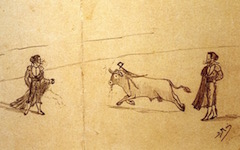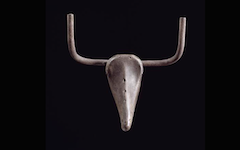Picasso’s Girl Before a Mirror (1932)
This 1932 painting by Picasso was inspired by Edouard Manet's Before the Mirror which we have already shown in a separate entry is really an image of a painter before his easel. Picasso, unlike art historians in his own time and since, understood this underlying level of meaning in Manet's art and used it himself.
Picasso, Girl Before a Mirror (1932) Oil on canvas. Museum of Modern Art, New york.
Click image to enlarge.
He borrowed the features of his blonde mistress Marie-Thérèse and turned her, as Manet had done another woman, into an artist in front of a metaphoric easel. Her arm is stretched out in front of her like a painter’s. The long, floppy fingers even emulate the feel and look of a paintbrush, the hand a suitable symbol for the brush. Though a woman, she is still a self-representation of the male artist as Picasso goes on to remind us.
Click next thumbnail to continue
Picasso confirmed his self-identification with Marie-Thérèse by shaping the mirror that frames her “painted” figure into the top half of a P for Picasso, minus its stem (see white area on the diagram). Picasso so often used various forms of the letter P to indicate himself that its presence here is unmistakeable.
Click next thumbnail to continue
He also distended the girl's abdomen to suggest pregnancy, a visual metaphor for the conception in his mind. That is why the stripes on her stomach are green, the color of fertility. The stripes themselves, meanwhile, are a reminder of the striped sailor's shirt Picasso so often wore when working.
In the background the circles on the wallpaper possibly represent a field of eyes indicating the all-over visual perception of his imagination as in the surface of a mirror. Robert Rosenblum separately noticed that the yellow and red of the wallpaper must also refer to the Spanish national colors, an observation now strengthened that the girl has been identified as the Spanish artist himself.1
However mystifying great art can be, and it can be very mystifying, it can also make sense.
More Works by Picasso
Notes:
1. Rosenblum, “The Spanishness of Picasso’s Still Lifes” in Picasso and the Spanish Tradition of Painting, ed. J. Brown (Yale University Press) 1996, pp.70-1
Original Publication Date on EPPH: 27 Oct 2010. | Updated: 0. © Simon Abrahams. Articles on this site are the copyright of Simon Abrahams. To use copyrighted material in print or other media for purposes beyond 'fair use', you must obtain permission from the copyright owner. Websites may link to this page without permission (please do) but may not reproduce the material on their own site without crediting Simon Abrahams and EPPH.




